Autumn Watercolor Flowers
This week I share an autumnal painting and talk about how dreams and everyday events get mixed in my art.

- In this project, I made the autumn watercolor flowers freely like in the course Freely Grown.
- The title “Satokauden kuulas” is a bit difficult to translate, but I explained it in the last paragraph.
- This piece is for sale at the online art store Taiko.art!
Autumn Moments
Although I usually aim for a grandiose atmosphere, my art is a lot about insignificant everyday moments.
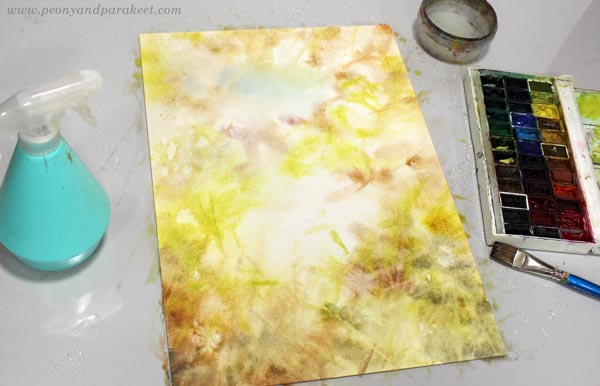
For example, when I …
- … gathered apples from our apple trees
- … walked in a rainy storm with the dogs
- … admired autumn colors from the car window.

Or when I smiled at the hopefulness of the roses in the front yard and promised to give them a home from a painting before winter would surprise them.
Floral Watercolor Dreams
When I paint in my small studio, my mind tells me that I am a flower painter in 17th or 18th century Holland. I imagine lovely high windows, old costumes, and the clatter of shoes on the street. I imagine the flower market and how I will assemble a bouquet from the best finds.

But in reality, I’m just an ordinary Finn whose everyday life pushes through the brush.
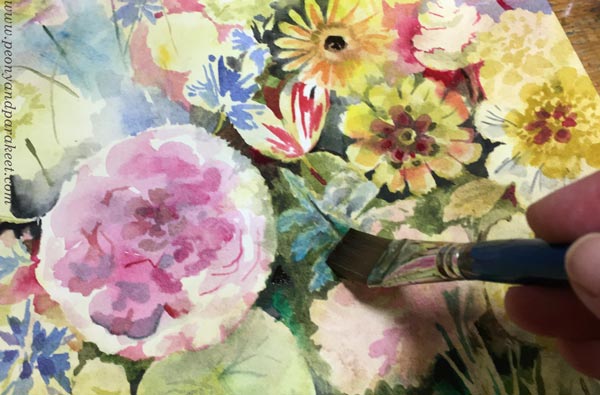
There is a huge gulf between me and the master painter of the 18th century and yet I still jump into it again and again. Every once in a while, I decide to stop painting flowers because there’s so much more to paint. And yes, if I look at my oil paintings, my favorites don’t have many flowers. Nevertheless, the flowerless period never lasts very long.

When I go to the garden, the Flemish master is waiting for me there. He says: “It’s time to practice again, Päivi” I answer: “Yes,” and then assure him: “One day I will master this art of painting flowers.”

Still, I know that life can be far too short and far too mundane for me to ever reach that level. But like a rose facing winter, I take out my button and wet the paper again.

This piece was painted on Arches Hot Press watercolor paper. It has a very smooth surface so it’s great for a detailed painting, but I also find it a bit challenging because every stroke shows!
What’s Behind the Title?
Even if I painted autumn watercolor flowers, can you also spot the apples?
This piece is called “Satokauden kuulas” and I think it’s a beautiful title in Finnish but a bit complicated to translate. “Satokausi” means harvest time and “kuulas” is a romantic word for translucent. But there’s more. “Valkea kuulas” is an apple variety that is called White Transparent in English. So I think that the suitable English name is “Harvest’s Transparent” even if it doesn’t quite have the same romantic sound as the Finnish version.

This piece has a strong autumnal feel: bright colors meet more muted tones on a dark background.
Does the weather also appear in your art?
Revamping Watercolor Painting with Watercolor Pencils
This week, I am revamping an old watercolor painting and sharing some things I have learned over the last five years. Let’s make your paintings more fantastic with five tips!

The size of my example is 28.5 cm x 28.5 cm, so 11.25 inches x 11.25 inches.
Revamping a Watercolor Painting – Best Candidates
Here are the original and the revamped paintings side by side.

I got the idea of the revamp when I was going through my old pieces to find ideas for the new course Joyful Coloring. The watercolor painting from 2019 had good paper and fairly light colors, so I knew it could be revamped quite easily. A part of the revamp is to wipe off some paint, so it helps if the paper is thick and durable. And the fewer layers the painting has, the easier it is to alter it.
Making the Old Version – Watch a Video from 2019!
In this video, I teach the negative painting technique. It’s very useful for watercolor because when you paint around the shape, you can highlight all the lightness and loveliness that has been born in the first layers.
The problem with highlighting the best parts is that we see too many. There’s a mental barrier to paint over them in later layers. And that makes the painting less atmospheric and more busy. Then it also remains less finished-looking than it could be. My painting definitely had these problems. Now I see it as a nice start, but not a finished piece.
Using Watercolor Pencils for Finishing
I could have continued the old painting with watercolors, but I want to grow my skills in using watercolor pencils. So I picked Caran d’Ache Museum Aquarelle pencils, filled a water cup, and chose a couple of narrow brushes. It’s easy to do very detailed things with watercolor pencils so they are suitable for finishing. The watercolor paper of my old painting was the Cold Press quality, so fairly textured, and Hot Press would have worked better for watercolor pencils. But I made the color more even with water, and it worked fine.
You can use any supplies for these tips! Tip #1 is the most important, so start your revamp with it.
Revamp #1 – Less Modesty – Make the Focal Point More Dashing!
What’s the central element in your piece? Is it the best treat of the painting, making you look at it again and again?
Mine was some sort of a daisy, much too modest and simple to my liking, and a bit clumsy too.
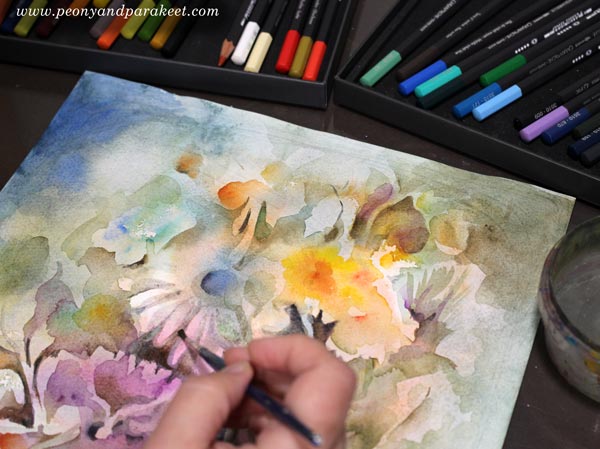
I started wiping off the darkest parts and then made it a peony. It’s a flower that has many layers of petals and is not a shy wallflower at all. Much more eye-catching!

It’s good to arrange some breathing room for the central element and add contrast to the background so that it stands out.
Revamp #2 – Less Bulkiness – Make Shapes More Elegant!
Do you have thick or straight lines? Do the shapes have extra angles? Are the negative shapes (background shapes) as beautiful as the actual shapes? Are many shapes connected to each other?
My painting had a lot of thick stems. Making them narrower immediately adds elegance to the flower. The stems were also very close to the flower and that makes the painting look flat. I added a dark color where the stem and the flower meet so that the flower stands out more.

My old painting had many shapes that looked quite random and not finished at all. I made them more organic and sharper.

But when revamping a watercolor painting, remember that everything doesn’t have to be sharp. The painting can have blurry spots as well, especially near the edges. Blurriness makes the sharp center stand out.
Revamp #3 – Less Evenness – Add More Subtle Patterns!
Have you used only one color on one area? Does your background look boring? Does your piece have an atmosphere?
My old piece had a background that was much too simple for my current taste. It didn’t have a sense of place at all. I want all my paintings to answer the question: “Where am I?” Even if it would be just an imaginary location, at best, the viewer can continue the scenery in her mind.

The background can have patterns. You can pick any idea suitable for fabric design! I wiped off the paint so that I got stripes going in all directions. This kind of bold patterning doesn’t improve the painting right away, but after tip #4, everything will get so much better!
Revamp #4 – Less Separate Color Areas – Add a Dominating Color to the Background!
Are your colors separate islands? Do you see problems in the composition? Is there too much of everything and a need to simplify?
The atmosphere can be often as simple as one color that dominates the background. However, it doesn’t mean that the background only has one tone. You can first add a variety of colors, and then color over them with one color. Separate colors are like strangers, but once they get the same color over them, they become a family. My choice was green, but yours can be any color.

Color a thin top layer so that the lower layers show through. You can color lightly and dilute the color with water.
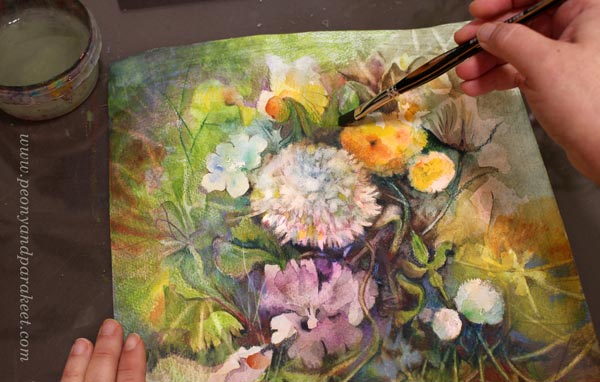
Don’t color over everything though. Leave out the details that you want to keep front!
Revamp #5 – Less Distracting Details – Choose Only a Few Shiny Stars!
Do you still see problems in the composition? Is there still too much to look at? Go through the painting and point your finger to every light and every dark area!
You most probably have too many white or pale pastel areas and/or too many dark areas. If you use high contrasts or very bright colors near the edges, the painting looks busy. Unfortunately, the best details often are born near the edges, but we don’t want the viewer to look there, so we must let them go.
When revamping a watercolor painting, use the dominating background color to cover the less important details. Compare the two pictures below and see how I have reduced the bright spots, for example, the two round flowers in the right bottom corner have been colored green in the final version.


In the center, the contrasts are good. So I made the background near my shiniest star – the peony – darker.
What a difference – isn’t it?!

I hadn’t signed the old painting, but I am so satisfied with the revamped version that I added my signature to it.
Joyful Coloring for Watercolor Pencils
Learn more about using watercolor pencils and create enjoyable projects!

What to Create with Colored Pencils? – Watch the Video!
This week I have a short inspirational video for you. I wanted to make a video that I can share on Instagram, so this has different portions than my videos usually are. You can watch it bigger by pressing the last icon on the menubar below the video.
Most of these drawings are made with regular colored pencils (or crayons as some call them) and some with watercolor pencils. I love both.
Coloring Freely on Blank Paper – Simple Start!
I am an advocate for coloring freely – starting with blank paper, adding colors on top of each other, and getting excited about what comes up. This doesn’t have to be anything difficult. Here’s an old picture from 2015 that I still find inspiring. You can illustrate your journaling with freely colored boxes.
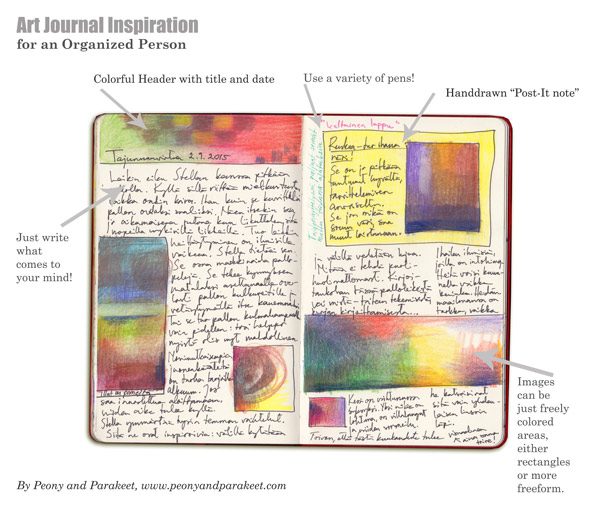
Children draw freely with colored pencils, but when they grow up and become “colored pencil artists” they need all kinds of references to get started. References are great for learning some techniques, but they don’t make anyone an artist. A big part of art is in our mind – how we open up and how we allow ourselves to break boundaries.
Growing Your Skills
My love for colored pencils is based on a promise that I have made for my inner child: I will color for you and help others to color for theirs. So even if I make oil paintings and media art too, colored pencils always have a special place in my heart.

So, welcome to my courses to improve your skills and expand your artistic thinking!
P.S. You can still sign up for Joyful Coloring!

Last Bloom – Watercolor Pencil Inspiration
This week we celebrate watercolor pencils and the lifecycle of flowers. I hope this post fills you with watercolor pencil inspiration!
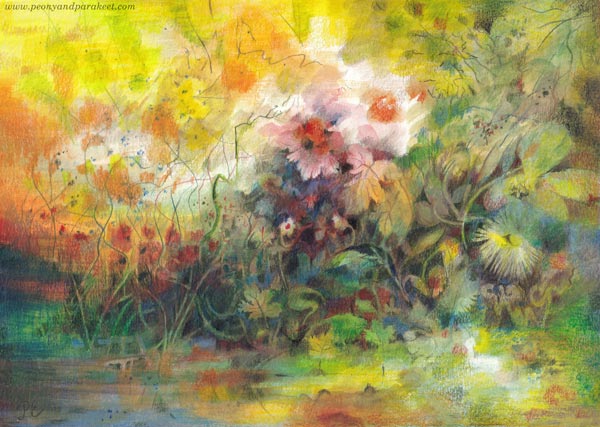
We in Finland have had a warm fall and many flowers are still blooming, even though it is already September. It inspired me to use yellows and oranges, which I love anyway.
Comforting Watercolor Pencil Inspiration
Lately, I’ve been editing videos for the upcoming course Joyful Coloring, which I recorded for the most part in the summer. I don’t know if the teacher can say it herself, the students decide that, but the videos are so inspiring!
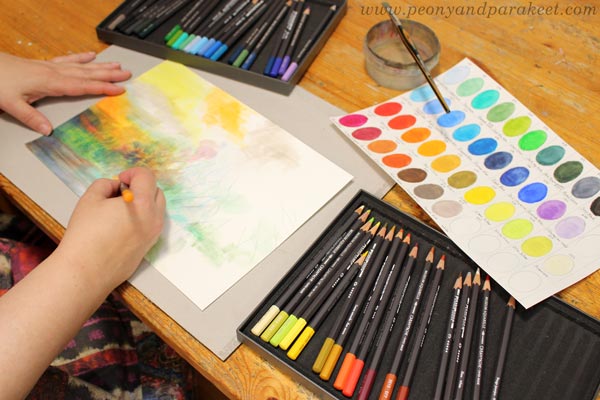
So watercolor pencils are really calling me now. I bought 20 more when I found them quite inexpensively, even though they are a good brand: Caran d’Ache Museum Aquarelle. And I also bought more paper – Fabriano Accademia Drawing Paper. It is not watercolor paper but works well for colored pencils and is more affordable. When you draw a lot, pencils and paper get used up.
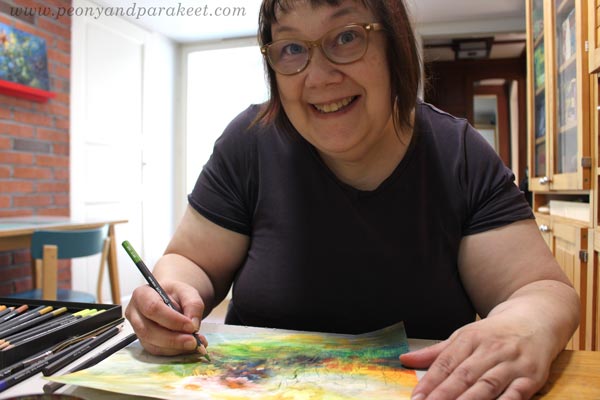
One of the best things about my job is that I can make “comfort drawings” for the blog. So, in the same way that there are comfort books, or comfort food, or comfort music, you can also make comfort drawings.
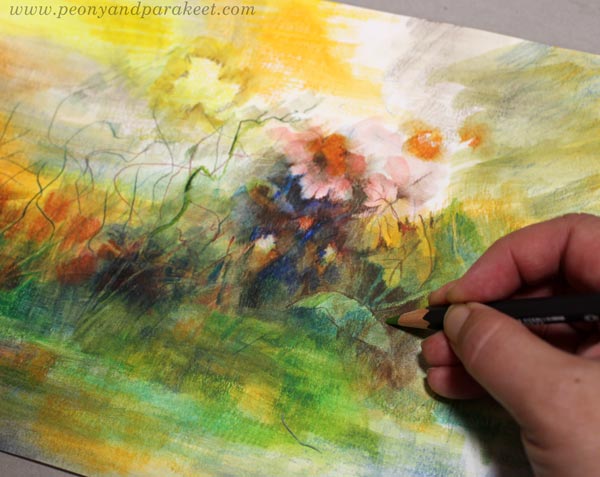
You can let colored pencils take care of all worries and unnecessary thoughts. Float in the sunshine and focus on everything beautiful!
Filling the Desert
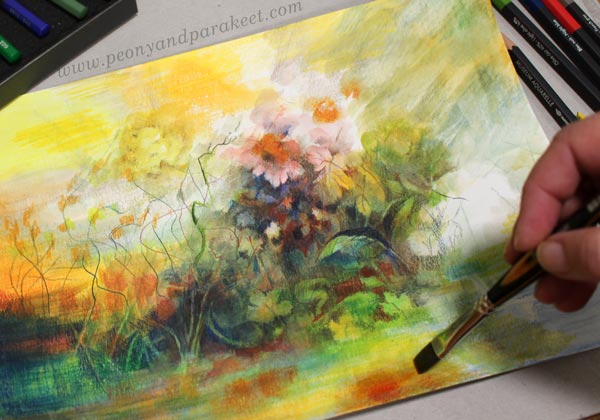
I like to start a drawing with a scenery, which I then fill. This method is also taught in the course Joyful Coloring.
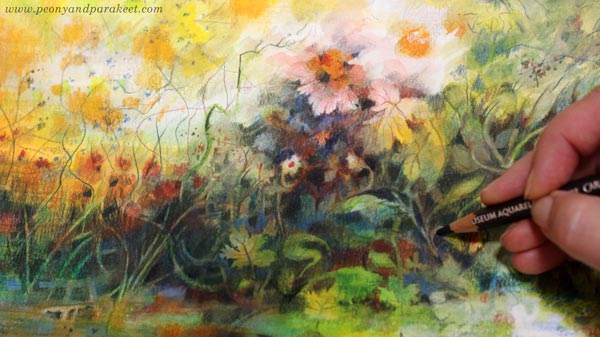
When immersing in the details, you can enjoy the fact that the world shrinks into a tiny area. I think that everything great and wonderful starts small. When thoughts decrease, possibilities expand. Then it is easier to invent and learn new things.
Meadow is a Town
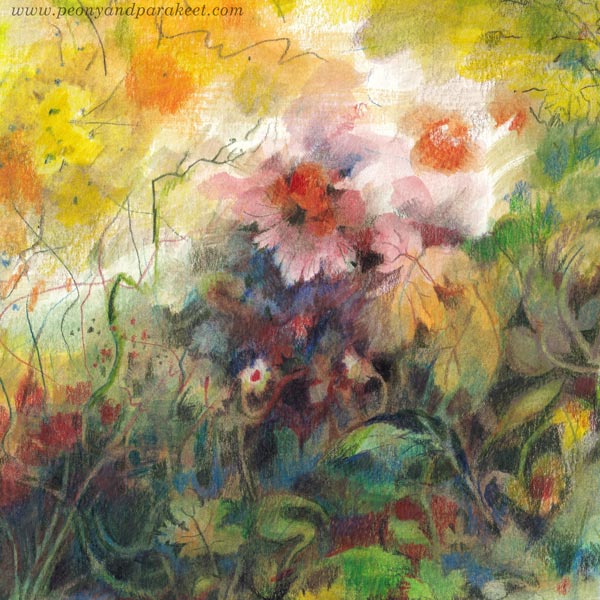
I have looked at the last flowers of summer and admired their details. It’s amazing how much there is in a small meadow flower: stems, seedcases, and flowers and leaves in different stages. And when you multiply those, the group of plants forms a busy town. A meadow is like an upright map of intersections, stations, and roads that guide the bees.
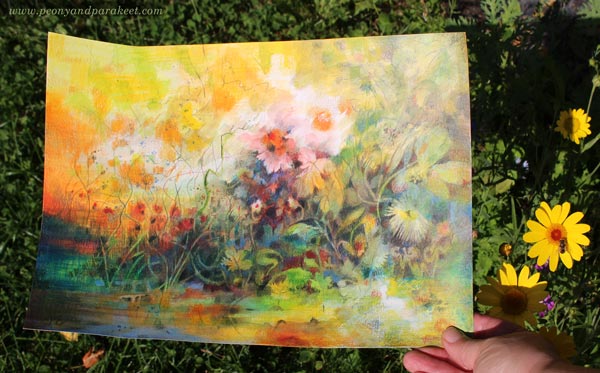
Colors of this kind of world are coming and going. Nothing is permanent and yet everything is so comforting and full of life.
Joyful Coloring – Sign up Now!
The new course Joyful Coloring begins on Sept 16!

Get your watercolor pencils and join me to create freely with joy and sunshine! >> Sign up now!